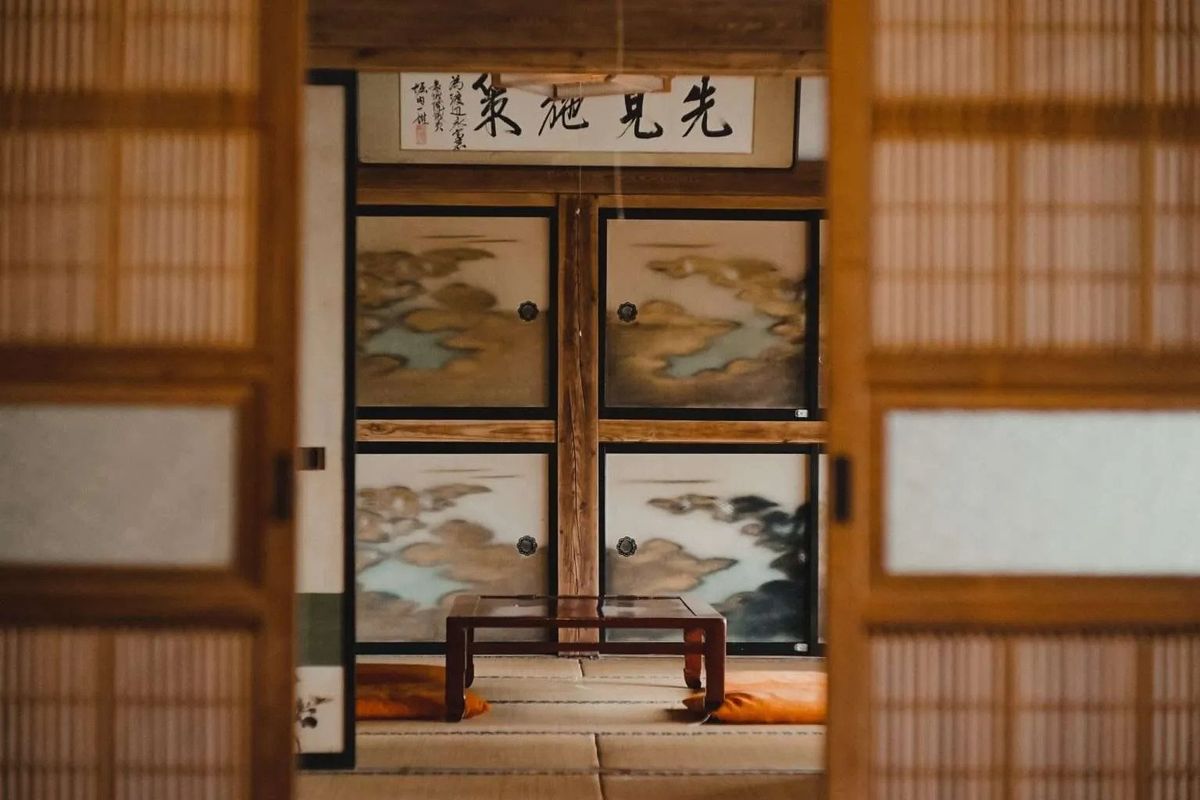Feel the timeless tradition and warm hospitality that let you soak in the essence of Japan's cultural heritage
When it comes to experiencing traditional Japanese hospitality, few things can compare to the enchanting stay at a ryokan. These cherished inns offer not just accommodation. But an intimate glimpse into the heart and soul of Japan's rich culture. Each moment spent within their walls is an invitation to embrace authenticity, steeped in the warmth of timeless traditions.
In this guide, we'll explore the fascinating history of ryokan, highlighting their key features and customs that enhance your stay. And we’ll also mention some of the most renowned ryokan locations you won't want to miss on your next trip to Japan.
Get ready to immerse yourself in a world where every detail tells a story, and the spirit of Japan warmly welcomes you.
What is a ryokan in a nutshell?
A ryokan (旅館) is a charming traditional Japanese inn typically located in scenic areas (e.g., hot springs or mountains). Offering a peaceful escape from city life, ryokan are renowned for their warm hospitality and authentic cultural experiences. You can enjoy tatami-matted rooms, communal baths, and cozy spaces while wearing a comfortable robe. They've been part of Japanese culture since the 8th century.
What’s the difference between ryokan and hotels?
Ryokan are usually cozier and more intimate than Western-style hotels. They give you a personal touch and a real connection with the local community. At ryokan, you can expect to see traditional Japanese design elements, like:
- Tatami (畳, woven straw mats)
- Shoji (障子, paper sliding doors)
- Fusuma (襖, sliding paper doors)
- Futon (布団, foldable mattresses)
- Tokonoma (床の間, alcoves for displaying artwork)
The layout of ryokan rooms also follows the traditional Japanese style of minimalism. This means you won't find any furniture, other than a low table and floor cushions. Instead, you sit on the floor or sleep on futons placed directly on tatami mats.
Is a ryokan the same as an onsen?
No, a ryokan isn't the same as an onsen (温泉). An onsen is a natural hot spring. But a lot of ryokan have their own communal baths that use onsen water. Which really enhances the whole experience and relaxation during your stay.
A little journey through history and evolution of ryokan
The history of ryokan dates back to the 8th century when Japan's capital was moved from Nara to Kyoto. This led to an increase in travelers and the need for places to stay. During this time, the concept of "ryo" (旅), meaning travel, and "kan" (館), meaning inn or house, combined to form the word "ryokan." Initially, ryokan were simple lodgings that catered mostly to pilgrims visiting temples and shrines. But as time passed, they evolved into places of rest and relaxation for travelers of all kinds.

Here's a brief overview of how ryokan began and evolved over time:
Nara period (710-794)
This was when Japan's capital was established in the historic city of Nara, a time of significant cultural and political changes. Ryokan were simple yet cozy inns for pilgrims visiting the city's famous temples. Playing a vital role in welcoming travelers.
These traditional Japanese inns provided a comfortable place to rest after long journeys, delicious meals to refuel, and bathing facilities for relaxation.
They offered comfort and created a sense of community among visitors. Making them ideal for spiritual and cultural exchanges.
Heian period (794-1185)
During this time, ryokan started to become popular among aristocrats and cultural elites looking for a break from the busy capital.
The growing appreciation for refined aesthetics and poetry became part of the experience at these inns.
Guests were attracted to the peaceful surroundings. Which often included beautifully curated gardens and traditional architecture meant to spark creativity and a connection to nature.
Kamakura period (1185-1333)
With the rise of the samurai class, ryokan grew to welcome not just the elite but also warriors and everyday travelers.
The impact of Zen Buddhism played a big role in shaping the vibe of ryokan, as the focus on simplicity and mindfulness became key to their design.
This created a calm atmosphere, helping guests feel more connected to their surroundings.
Muromachi period (1336-1573)
The look of ryokan changed a lot during this time. Influenced by the ideas of wabi-sabi (which celebrate the beauty of imperfection and the fleeting nature of life).
Accommodations became more minimalist. Embracing simplicity that attracted guests looking for comfort and a spiritual vibe.
This era marked a mix of practicality and artistic flair. Showcasing the harmonious bond between guests and nature.
Edo period (1603-1868)
As Japan enjoyed a time of peace and stability, ryokan became very popular. And started attracting a wider variety of travelers.
Local artisans played a big role in shaping the unique vibe of ryokan across the country. Often highlighting regional craftsmanship and delicious food.
The ryokan culture really took off. Offering visitors not just a place to rest, but a deeper dive into Japan's customs and traditions.
Modern era
In the 20th century, as travel and tourism took off, ryokan adapted to meet the needs of a global crowd.
By adding modern amenities like private bathrooms and Western-style bedding, they offered a comfy stay while still holding onto the charm of traditional Japanese hospitality.
Today, ryokan are still beloved spots for travelers looking for an authentic cultural experience in Japan. Each one gives a unique look into the country’s rich history and changing identity. Making them a must-visit on any trip to this enchanting land.
If you're drawn to the calm beauty and mindfulness of ryokan, diving into the art of Japanese Zen gardens will deepen your appreciation for tranquility and harmony in Japanese culture:

Key features and amenities of ryokan
Ryokan embody a minimalist aesthetic that resonates deeply with the heart of Japanese culture. These serene havens embrace simplicity and natural beauty. Inviting you to immerse yourself in the tranquil surroundings. The design whispers a call for quiet contemplation, gently guiding you to cut through the noise of everyday life. In these open spaces, where distractions fade away, you can truly savor the profound peace that simplicity brings.

Here are some key features and amenities you can expect at most ryokan:
Sliding doors (fusuma) and paper screens (shoji)
These delicate doors and screens allow for natural light to fill the room, creating a serene atmosphere. They also offer privacy and can be opened or closed depending on your preference.
Tatami-matted rooms
These floors are made of soft, woven straw mats that provide a warm and comfortable feeling. The size of the room can be specified in terms of the number of tatami mats.
Kaiseki (懐石) cuisine
This traditional multi-course meal showcases fresh, seasonal ingredients served in an artistic fashion. It often includes local specialties and is served in the comfort of your own room.
Cultural activities
Depending on the location and style of the ryokan, there may be additional cultural activities such as calligraphy lessons, flower arranging, or even samurai sword demonstrations available for guests to participate in. These activities are a great way to learn more about Japanese culture and traditions.
Communal baths
Many ryokan offer communal hot spring baths, also known as onsen. You can enjoy this relaxing experience while wearing the provided yukata (浴衣), a lightweight cotton robe worn over your clothes.
Futon bedding
Unlike Western-style beds, futons are thin mattresses that are placed directly on the tatami mats. They can easily be stored away during the day, allowing for more space in the room.
Tea ceremony
Some ryokan offer a traditional tea ceremony experience as part of their hospitality. This ritual involves carefully preparing matcha (powdered green tea) and serving it with sweet treats while guests sit on tatami mats.
Yukata rental
Many ryokan offer yukata rental for their guests, allowing you to fully immerse yourself in the traditional experience of wearing these cotton robes during your stay.
This laid-back approach to design transforms your stay into a journey of comfort while creating a deeper connection with nature and your innermost self. It’s in these moments of reflection and mindfulness that you discover the beauty of the world around you. Inviting wonder and discovery into your heart.
Ryokan are not just places to stay. They are sacred spaces that celebrate the essence of being present in the moment.
What can I expect during a stay at a ryokan?
Staying at a ryokan is an experience in itself. From the moment you step through the entrance, you will be transported to another time and place.
Here are some things to expect during your stay at a ryokan:
- Genkan (玄関): The entrance of a traditional ryokan typically has a raised flooring called genkan. This area is where guests remove their shoes before entering the main building.
- Omotenashi (おもてなし): This Japanese concept of hospitality is deeply ingrained in the ryokan experience. It refers to the warm, welcoming and attentive service provided by the staff to make you feel at home.
- Check-in process: The check-in process at a ryokan can take longer than at a typical hotel. This is because the staff may explain the amenities and rules of the ryokan, as well as answer any questions you may have.
- Serving of tea and snacks: Upon arrival, you will be served a cup of tea and some traditional Japanese snacks as a welcome gesture.
- Slippers or barefoot walking: Once inside, you'll get slippers to wear while exploring the common areas of the ryokan. But it’s a common practice to take them off before you enter your room or step onto the tatami mats. Some ryokan may also you to walk barefoot in their rooms.
- Dinner and breakfast service: As mentioned before, most ryokan offer kaiseki cuisine for dinner and breakfast. Meals are usually served at specific times in your room or in a communal dining area depending on the ryokan's style.
- Bedtime preparations: After dinner, a staff member will come to your room to prepare your futon bedding while you relax in the common area or take a bath.
- Quiet hours: Ryokan are known for their peaceful atmosphere, so it's best to keep it down during quiet hours. This means lowering noise levels and avoiding loud activities or conversations late at night.
- Check-out process: When it is time to check out, you will often be served a cup of tea and a light snack as a farewell gesture.
Staying at a ryokan lets you take life at a slower pace, where you can really savor and appreciate every moment. It’s a great chance to disconnect from the daily chaos and reconnect with yourself and nature.
And what are the etiquette and customs at a ryokan?
As with any cultural experience, it's important to be mindful of some etiquette and customs when staying at a ryokan.
Here are a few guidelines on how to stay at a ryokan:
- Bowing: When you meet or greet someone at a ryokan, it’s common to bow. It’s a nice way to show respect and appreciation for the other person.
- Shoes off: As mentioned earlier, you should remove shoes in the genkan area before entering the main building.
- Dining etiquette: When you're enjoying your kaiseki meal, it's polite to wait until everyone is served before you start eating. Also, remember to hold your bowl close to your mouth when eating rice or soup. And try not to stick your chopsticks upright in your bowl, since that's a gesture linked to funerals.
- Bathing etiquette: If the ryokan has communal baths, there are specific rules to follow. These include washing your body before entering, keeping quiet in the bath area, tying up hair and keeping it out of the water, and not using towels inside the bath.
- Behave respectfully: Ryokan are places of tranquility and relaxation. So it's important to behave respectfully towards other guests and staff members. This means keeping noise levels down and being considerate of others.
- Using yukata properly: If you choose to wear a yukata during your stay, it's important to know how to properly put it on and tie the obi (sash). Staff members at the ryokan can assist you with this if needed.
- Tipping is not expected: Tipping is not a common practice in Japan. Including at ryokan. The staff is already providing excellent service as part of omotenashi. So it's not necessary to leave a tip.
- Respect the property and nature: In line with Japanese culture, it's important to respect the property and nature at ryokan. This includes keeping your room tidy, disposing of trash properly, and not damaging or removing any natural elements from the premises.
By sticking to these simple tips, you can dive into the ryokan experience while respecting Japan's culture and traditions.
Are you interested in the serene side of Japan? In this article you can find more tips on how to have a relaxing and rejuvenating trip in Japan:

7 famous ryokan to visit in Japan
Experiencing the serene atmosphere of a ryokan for the first time is an encounter that resonates long after you depart.
Imagine stepping into a realm where simplicity and tradition harmoniously coexist. As you walk through the wooden hallways adorned with tatami mats, each corner unfolds with carefully selected decor that reflects nature's grace.
The gentle fragrance of tatami mingles with the scent of green tea, inviting you to unwind.
Every moment spent within the ryokan encourages contemplation. Offering a unique opportunity to disconnect from the frenzy of modern life. And reconnect with your inner self.
This journey into the heart of Japanese culture is more than just a stay. It's a heartfelt exploration of peace, hospitality, and time-honoured rituals.

Here are some renowned ryokan that embody this essence:
- Nishimuraya Honkan: Situated in the charming town of Kinosaki Onsen, this ryokan has been in operation for over 150 years. Its hot spring baths, seasonal kaiseki meals, and peaceful surroundings make it a popular choice for travelers.
- Hoshinoya Tokyo: This modern ryokan in the heart of Tokyo offers a blend of traditional Japanese aesthetics and contemporary luxury. With its serene setting and top-notch hospitality, it's the perfect retreat if you want to relax in the bustling city.
- Tawaraya Ryokan: Another renowned ryokan in Kyoto, Tawaraya offers a more intimate experience with only 18 guest rooms. It has a tranquil atmosphere, spacious rooms with private gardens, and a multi-course kaiseki dinner.
- Hiiragiya Ryokan: This traditional ryokan in Kyoto is a favorite among celebrities and dignitaries. It offers beautifully decorated rooms with views of a Japanese garden, along with top-notch service and delicious kaiseki cuisine.
- Hakone Ginyu: Tucked away in the beautiful Hakone mountains, this modern ryokan has spacious rooms with private open-air hot spring baths. It also offers fun activities like yoga and tea ceremony classes for a complete wellness experience.
- Gora Kadan: Located in Hakone, this historic ryokan was once a vacation home for the Imperial Family. It features stunning mountain views, relaxing natural hot springs, and delicious kaiseki cuisine.
- Houshi: As one of the oldest ryokan in Japan, Houshi is rich in history and tradition. Located in the hot spring town of Awazu, it offers breathtaking views of the surrounding mountains and serves delicious local cuisine.
Here's an interactive map (and route) highlighting the locations of all 7 ryokan:
Of course, these are just a few examples. There are so many ryokan all over Japan. And each with its own unique charm and character. But all these Japanese inns offer a memorable experience. Making them a great choice if you want to dive into Japanese culture and relax in a peaceful setting.
Ryokan are Japanese inns that embrace tradition and tranquility
Ryokan are more than just places to stay. They are gateways to experiencing the heart of Japanese culture and heritage.
Every ryokan embodies a unique hospitality philosophy that puts your comfort and experience first. These peaceful retreats invite you to dive into a world where every detail is thoughtfully designed for relaxation and reflection. From the artful kaiseki dining to the relaxing onsen baths, every aspect of a ryokan encourages you to take a breather and reconnect with yourself and your surroundings.
As you experience the flowing motions of a traditional tea ceremony or the serene beauty of a garden pond, you are reminded of the significance of mindfulness and appreciation for the present moment.
In the quietude of a ryokan, the rhythms of nature become more palpable. This reminds us to appreciate the little things in life and those fleeting moments that make it special.
P.S. Here's a video I found that captures the beauty and tranquility of a ryokan:
Staying at a Japanese Ryokan by It's time to travel.






Comments ()